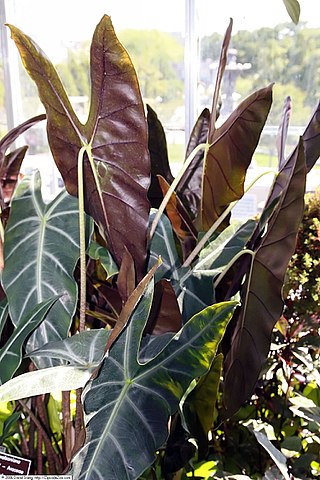
The Araceae are a family of monocotyledonous flowering plants in which flowers are borne on a type of inflorescence called a spadix. The spadix is usually accompanied by, and sometimes partially enclosed in, a spathe. Also known as the arum family, members are often colloquially known as aroids. This family of 140 genera and about 4,075 known species is most diverse in the New World tropics, although also distributed in the Old World tropics and northern temperate regions.

Acorus is a genus of monocot flowering plants. This genus was once placed within the family Araceae (aroids), but more recent classifications place it in its own family Acoraceae and order Acorales, of which it is the sole genus of the oldest surviving line of monocots. Some older studies indicated that it was placed in a lineage, that also includes aroids (Araceae), Tofieldiaceae, and several families of aquatic monocots. However, modern phylogenetic studies demonstrate that Acorus is sister to all other monocots. Common names include calamus and sweet flag.

Anthurium is a genus of about 1,000 species of flowering plants, the largest genus of the arum family, Araceae. General common names include anthurium, tailflower, flamingo flower, and laceleaf.

Epimedium sagittatum is a flowering plant in the barberry family (Berberidaceae) native to China. It is known locally as 三枝九叶草 and is sometimes called horny goat weed for its purported aphrodisiac properties.

Cocoyam is a common name for more than one tropical root crop and vegetable crop belonging to the Arum family and may refer to:

Gynerium is a monotypic genus of Neotropical plants in the grass family, native to Mexico and Colombia, Central America, South America, and the West Indies. It is classified in its own tribe Gynerieae.
The Aroid or Ari-Banna languages possibly belong to the Afro-Asiatic family and are spoken in Ethiopia.
Johann Joseph Peyritsch was an Austrian physician and botanist born in Völkermarkt.
A rheophyte is a plant that lives in fast moving water currents in an environment where few other organisms can survive. Rheophytes tend to be found in currents that move at rates of one to two meters per second and that are up to 1 to 2 m deep. The amount of force produced by these currents, and the damaging debris they can carry, makes this environment inhospitable to most plants. Rheophytes are able to live in such environments because their leaves are streamlined so as put up little resistance to the flow of water. The leaves tend to be quite narrow and flexible as well. Simply being an aquatic plant with narrow leaves is not a sufficient condition for being a rheophyte. In order to prevent being uprooted by the rushing currents, rheophytes have an extremely strong wide spreading root system.

Aroideae is a subfamily of flowering plants in the family Araceae. It is the largest subfamily in Araceae and consists of about 72 different genera, and 2,300 species. Many Aroideae have spiny pollen grains without a sporopollenin outer exine layer and lacking an aperture.
Bognera is a monotypic genus of flowering plants in the family Araceae. The single species that makes up the genus is Bognera recondita. The word recondita means "hidden" referring to the fact that the plant is only found in remote areas of Amazonian Brazil near the Peruvian border. The species was discovered in the late 1970s and was originally placed in the genus Ulearum, as Ulearum reconditumMadison, Aroideana 3: 101 (1980).

Ulearum is a genus of flowering plants in the family Araceae. It contains two known species, both native to South America. Ulearum is similar to Callopsis, but Callopsis is found only in Africa and so its relation is uncertain.

Pothoideae is a subfamily of flowering plants in the family Araceae. The species in the subfamily are true aroids.
Metastachydium is a genus of flowering plant in the family Lamiaceae, first described with this name in 1977. It contains only one known species, Metastachydium sagittatum, native to central Asia.

Thaumatophyllum xanadu is a perennial plant belonging to the arum family Araceae and the genus Thaumatophyllum, formerly classified under the Meconostigma subgenus of Philodendron. This plant is native to Brazil, but is widely cultivated as a landscape plant in tropical, subtropical and warm temperate climates.

Microloma sagittatum, the bokhoring, is a species of plant in the family Apocynaceae, that is native to the south-western Cape, South Africa.

Asplenium sagittatum is a species of fern in the family Asplenium (spleenworts). Individuals can grow to 3.2 cm (1.3 in) tall.

Alocasia longiloba is a species of flowering plant in the family Araceae. It is the namesake of a species complex. The complex has a widespread distribution; Guangdong, Hainan, and southern Yunnan in China, mainland Southeast Asia, and western and central Malesia.
Ulearum donburnsii is a species of plant in the family Araceae. Native to the Amazonian lowlands of Ecuador, it can be distinguished from its relative Ulearum sagittatum by the finer, thread-like staminodes on its spadix. It has arrowhead-shaped leaves and grows terrestrially from small rhizomes. The species was described in 2003 and named for Don Burns, a noted grower of aroids and a member of the International Aroid Society.













